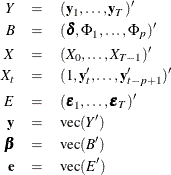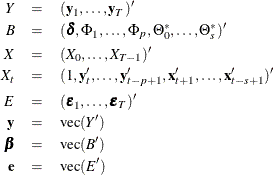The VARMAX Procedure
- Overview
-
Getting Started

-
Syntax

-
Details
 Missing ValuesVARMAX ModelDynamic Simultaneous Equations ModelingImpulse Response FunctionForecastingTentative Order SelectionVAR and VARX ModelingSeasonal Dummies and Time TrendsBayesian VAR and VARX ModelingVARMA and VARMAX ModelingModel Diagnostic ChecksCointegrationVector Error Correction ModelingI(2) ModelVector Error Correction Model in ARMA FormMultivariate GARCH ModelingOutput Data SetsOUT= Data SetOUTEST= Data SetOUTHT= Data SetOUTSTAT= Data SetPrinted OutputODS Table NamesODS GraphicsComputational Issues
Missing ValuesVARMAX ModelDynamic Simultaneous Equations ModelingImpulse Response FunctionForecastingTentative Order SelectionVAR and VARX ModelingSeasonal Dummies and Time TrendsBayesian VAR and VARX ModelingVARMA and VARMAX ModelingModel Diagnostic ChecksCointegrationVector Error Correction ModelingI(2) ModelVector Error Correction Model in ARMA FormMultivariate GARCH ModelingOutput Data SetsOUT= Data SetOUTEST= Data SetOUTHT= Data SetOUTSTAT= Data SetPrinted OutputODS Table NamesODS GraphicsComputational Issues -
Examples

- References
VAR and VARX Modeling
The pth-order VAR process is written as

with  .
.
Equivalently, it can be written as

with  .
.
Stationarity
For stationarity, the VAR process must be expressible in the convergent causal infinite MA form as

where  with
with  , where
, where  denotes a norm for the matrix A such as
denotes a norm for the matrix A such as  . The matrix
. The matrix  can be recursively obtained from the relation
can be recursively obtained from the relation  ; it is
; it is

where  and
and  for
for  .
.
The stationarity condition is satisfied if all roots of  are outside of the unit circle. The stationarity condition is equivalent to the condition in the corresponding VAR(1) representation,
are outside of the unit circle. The stationarity condition is equivalent to the condition in the corresponding VAR(1) representation,
 , that all eigenvalues of the
, that all eigenvalues of the  companion matrix
companion matrix  be less than one in absolute value, where
be less than one in absolute value, where  ,
,  , and
, and
![\begin{eqnarray*} \Phi = \left[ \begin{matrix} \Phi _1 & \Phi _2 & \cdots & \Phi _{p-1} & \Phi _{p} \\ I_ k & 0 & \cdots & 0 & 0 \\ 0 & I_ k & \cdots & 0 & 0 \\ \vdots & \vdots & \ddots & \vdots & \vdots \\ 0 & 0 & \cdots & I_ k & 0 \\ \end{matrix} \right] \end{eqnarray*}](images/etsug_varmax0539.png)
If the stationarity condition is not satisfied, a nonstationary model (a differenced model or an error correction model) might be more appropriate.
The following statements estimate a VAR(1) model and use the ROOTS option to compute the characteristic polynomial roots:
proc varmax data=simul1; model y1 y2 / p=1 noint print=(roots); run;
Figure 42.59 shows the output associated with the ROOTS option, which indicates that the series is stationary since the modulus of the eigenvalue is less than one.
Figure 42.59: Stationarity (ROOTS Option)
Parameter Estimation
Consider the stationary VAR(p) model

where  are assumed to be available (for convenience of notation). This can be represented by the general form of the multivariate
linear model,
are assumed to be available (for convenience of notation). This can be represented by the general form of the multivariate
linear model,

where

with vec denoting the column stacking operator.
The conditional least squares estimator of  is
is
![\[ \hat{ \bbeta } = ( (X’X)^{-1}X’\otimes I_ k)\mb{y} \]](images/etsug_varmax0544.png)
and the estimate of  is
is
![\[ \hat\Sigma = (T-(kp+1))^{-1}\sum _{t=1}^ T \hat{\bepsilon _ t} \hat{\bepsilon _ t}’ \]](images/etsug_varmax0545.png)
where  is the residual vectors. Consistency and asymptotic normality of the LS estimator are that
is the residual vectors. Consistency and asymptotic normality of the LS estimator are that
![\[ \sqrt {T}(\hat{\bbeta } -\bbeta )\stackrel{d}{\rightarrow } N(0, \Gamma _ p^{-1} \otimes \Sigma ) \]](images/etsug_varmax0547.png)
where  converges in probability to
converges in probability to  and
and  denotes convergence in distribution.
denotes convergence in distribution.
The (conditional) maximum likelihood estimator in the VAR(p) model is equal to the (conditional) least squares estimator on the assumption of normality of the error vectors.
Asymptotic Distributions of Impulse Response Functions
As before, vec denotes the column stacking operator and vech is the corresponding operator that stacks the elements on and below the diagonal. For any  matrix A, the commutation matrix
matrix A, the commutation matrix  is defined as
is defined as  ; the duplication matrix
; the duplication matrix  is defined as
is defined as  ; the elimination matrix
; the elimination matrix  is defined as
is defined as  .
.
The asymptotic distribution of the impulse response function (Lütkepohl 1993) is
![\[ \sqrt {T} \mr{vec} (\hat\Psi _ j - \Psi _ j ) \stackrel{d}{\rightarrow } N(0, G_ j\Sigma _{\bbeta } G_ j’) ~ ~ j=1,2,\ldots \]](images/etsug_varmax0557.png)
where  and
and
![\[ G_ j= \frac{\partial \mr{vec} (\Psi _ j)}{\partial {\bbeta }'} = \sum _{i=0}^{j-1} \mb{J} ({\bPhi }’)^{j-1-i}\otimes \Psi _ i \]](images/etsug_varmax0559.png)
where ![$\mb{J} = [ I_ k, 0,\ldots , 0 ]$](images/etsug_varmax0560.png) is a
is a  matrix and
matrix and  is a
is a  companion matrix.
companion matrix.
The asymptotic distribution of the accumulated impulse response function is
![\[ \sqrt {T} \mr{vec} (\hat\Psi ^{a}_ l - \Psi ^{a}_ l ) \stackrel{d}{\rightarrow } N(0, F_ l\Sigma _{\bbeta } F_ l’) ~ ~ l=1,2,\ldots \]](images/etsug_varmax0564.png)
where  .
.
The asymptotic distribution of the orthogonalized impulse response function is
![\[ \sqrt {T} \mr{vec} (\hat\Psi ^{o}_ j - \Psi ^{o}_ j ) \stackrel{d}{\rightarrow } N(0, C_ j\Sigma _{\bbeta } C_ j’ +\bar{C_ j}\Sigma _{\bsigma } \bar{C_ j'}) ~ ~ j=0,1,2,\ldots \]](images/etsug_varmax0566.png)
where  ,
,  ,
,  ,
,
![\[ H=\frac{\partial \mr{vec} (\Psi ^{o}_0)}{\partial {\bsigma }'} =L’_ k\{ L_ k(I_{k^2}+K_ k)(\Psi ^{o}_0 \otimes I_ k)L’_ k\} ^{-1} \]](images/etsug_varmax0570.png)
and  with
with  and
and  .
.
Granger Causality Test
Let  be arranged and partitioned in subgroups
be arranged and partitioned in subgroups  and
and  with dimensions
with dimensions  and
and  , respectively (
, respectively ( ); that is,
); that is,  with the corresponding white noise process
with the corresponding white noise process  . Consider the VAR(p) model with partitioned coefficients
. Consider the VAR(p) model with partitioned coefficients  for
for  as follows:
as follows:
![\begin{eqnarray*} \left[\begin{matrix} \Phi _{11}(B) & \Phi _{12}(B) \\ \Phi _{21}(B) & \Phi _{22}(B) \\ \end{matrix}\right] \left[\begin{matrix} \mb{y} _{1t} \\ \mb{y} _{2t} \\ \end{matrix}\right] = \left[\begin{matrix} \bdelta _{1} \\ \bdelta _{2} \\ \end{matrix}\right] + \left[\begin{matrix} \bepsilon _{1t} \\ \bepsilon _{2t} \\ \end{matrix}\right] \end{eqnarray*}](images/etsug_varmax0582.png)
The variables  are said to cause
are said to cause  , but
, but  do not cause
do not cause  if
if  . The implication of this model structure is that future values of the process
. The implication of this model structure is that future values of the process  are influenced only by its own past and not by the past of
are influenced only by its own past and not by the past of  , where future values of
, where future values of  are influenced by the past of both
are influenced by the past of both  and
and  . If the future
. If the future  are not influenced by the past values of
are not influenced by the past values of  , then it can be better to model
, then it can be better to model  separately from
separately from  .
.
Consider testing  , where C is a
, where C is a  matrix of rank s and c is an s-dimensional vector where
matrix of rank s and c is an s-dimensional vector where  . Assuming that
. Assuming that
![\[ \sqrt {T}(\hat{\bbeta } -\bbeta )\stackrel{d}{\rightarrow } N(0, \Gamma _ p^{-1} \otimes \Sigma ) \]](images/etsug_varmax0547.png)
you get the Wald statistic
![\[ T(C \hat{\bbeta } -c)’ [C({\hat\Gamma _ p}^{-1} \otimes {\hat\Sigma })C’]^{-1} (C \hat{\bbeta } -c) \stackrel{d}{\rightarrow } \chi ^2(s) \]](images/etsug_varmax0587.png)
For the Granger causality test, the matrix C consists of zeros or ones and c is the zero vector. See Lütkepohl (1993) for more details of the Granger causality test.
VARX Modeling
The vector autoregressive model with exogenous variables is called the VARX(p,s) model. The form of the VARX(p,s) model can be written as

The parameter estimates can be obtained by representing the general form of the multivariate linear model,

where

The conditional least squares estimator of  can be obtained by using the same method in a VAR(p) modeling. If the multivariate linear model has different independent variables that correspond to dependent variables, the
SUR (seemingly unrelated regression) method is used to improve the regression estimates.
can be obtained by using the same method in a VAR(p) modeling. If the multivariate linear model has different independent variables that correspond to dependent variables, the
SUR (seemingly unrelated regression) method is used to improve the regression estimates.
The following example fits the ordinary regression model:
proc varmax data=one; model y1-y3 = x1-x5; run;
This is equivalent to the REG procedure in the SAS/STAT software:
proc reg data=one; model y1 = x1-x5; model y2 = x1-x5; model y3 = x1-x5; run;
The following example fits the second-order lagged regression model:
proc varmax data=two; model y1 y2 = x / xlag=2; run;
This is equivalent to the REG procedure in the SAS/STAT software:
data three; set two; xlag1 = lag1(x); xlag2 = lag2(x); run; proc reg data=three; model y1 = x xlag1 xlag2; model y2 = x xlag1 xlag2; run;
The following example fits the ordinary regression model with different regressors:
proc varmax data=one; model y1 = x1-x3, y2 = x2 x3; run;
This is equivalent to the following SYSLIN procedure statements:
proc syslin data=one vardef=df sur; endogenous y1 y2; model y1 = x1-x3; model y2 = x2 x3; run;
From the output in Figure 42.21 in the section Getting Started: VARMAX Procedure, you can see that the parameters, XL0_1_2, XL0_2_1, XL0_3_1, and XL0_3_2 associated with the exogenous variables, are not significant. The following example fits the VARX(1,0) model with different regressors:
proc varmax data=grunfeld; model y1 = x1, y2 = x2, y3 / p=1 print=(estimates); run;
Figure 42.60: Parameter Estimates for the VARX(1, 0) Model
As you can see in Figure 42.60, the symbol ‘_’ in the elements of matrix corresponds to endogenous variables that do not take the denoted exogenous variables.